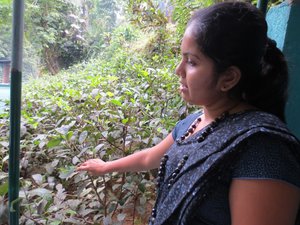Advertisement
Published: October 7th 2013

 Tea bushes with guide
Tea bushes with guide
Our lovely guide led us up lots of steep steps for the start of the tour. Here she shows us growing tea bushes and explains how the pickers aim for "two leaves and a bud". Only the very young leaves are made into tea.Mountains of Tea:
When I was growing up in Massachusetts, I remember learning the song "I'm a little teapot short and stout, here is my handle, here is my spout..." and performing the actions to it. But it clearly didn't make much of an impression on me--I guess it seemed a quaint Alice-in-Wonderland sort of device. The only tea I knew was the Lipton's teabag we put in Mum's cup each night when we set the table.
So when I went to Australia at age 23, I had no idea what to do with loose tea leaves and my new Australian friends were aghast to see me drop some leaves in a cup, pour in hot water and strain the leaves out with my teeth as I drank it. Obviously, I'm not a tea aficionado.
However, I do have a healthy curiosity about things in general and as tea is a big deal here--Sri Lanka is the world's biggest exporter of tea and it factors high in the country's income--I was very interested in going to a tea factory to see what I could see.
Much of the central mountain slopes of Sri Lanka are covered in

 Withering the tea
Withering the tea
The first step in tea making is to wither the leaves in large open bins.tea plantations and "Up Country Tea" is prized for its flavour. In fact in Kandy and Nuwara Eliya, going to a tea factory is almost de rigueur for visitors.
The start of the tea industry in Sri Lanka's high country is credited to a Scotsman named James Taylor in about 1852. (Not of "Sweet Baby James" fame.) After the plan to grow coffee failed disastrously due to a blight, plantings were switched to tea and it worked.
For the most part this tea is still tended by Indian Tamils, whose families migrated to Sri Lanka as agricultural workers in the mid to late 1800s. It is worth noting that they are a separate group from the Tamils who have lived in the north of Sri Lanka for many centuries.
The tea industry became huge and was eventually nationalized under the socialist government of the 1970s, but it turned out that men of government are not necessarily savvy tea growers, and after great financial losses, the industry was given back to commercial interests in the 1990s.
I found the entire history and process fascinating but I must admit the biggest shock I got was to

 Withering frames
Withering frames
The entire top floor of the 4-story tea factory is given over to withering.learn that it's the lowly TEA DUST which goes into teabags.
Real tea drinkers don't use bags--they choose tea LEAVES of many varieties and sizes and reputations. And they brew these leaves in TEAPOTS, little or big, fancy or plain, and they knit little sweaters (jumpers) for them called tea cosies, which are very colourful and fanciful, to keep up the temperature in the pot.
There's even a raging debate about whether you take the kettle from the stove to the teapot to pour in the boiling water, or you take the pot to the kettle.
People who know tea live in a world where odd abbreviations are meaningful. For example, BOP stands for Broken Orange Pekoe, which are Orange Pekoe leaves which have not just been rolled but have also been put through another pressure/grinding machine to break them. BOP is said to be best with milk, given its strong flavour.
As for us, Phil will take a teabag any day, and whatever interesting fruit flavour I choose to drink he refers to globally as "hippy tea".
Advertisement
Tot: 0.113s; Tpl: 0.014s; cc: 5; qc: 47; dbt: 0.0659s; 1; m:domysql w:travelblog (10.17.0.13); sld: 1;
; mem: 1.1mb

 Tea bushes with guide
Tea bushes with guide 
 Withering the tea
Withering the tea
 Withering frames
Withering frames























Michelle
non-member comment
Tea!
As a lover of a cuppa I was surprised, and thankful to you to discover that tea bags only contain tea dust. I'll try to only drink leaf tea in future. It all sounds very interesting. M xx